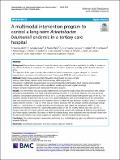Por favor, use este identificador para citar o enlazar a este item:
http://hdl.handle.net/10261/212385COMPARTIR / EXPORTAR:
 SHARE SHARE
 CORE
BASE CORE
BASE
|
|
| Visualizar otros formatos: MARC | Dublin Core | RDF | ORE | MODS | METS | DIDL | DATACITE | |

| Título: | A multimodal intervention program to control a long-term Acinetobacter baumannii endemic in a tertiary care hospital |
Autor: | Valencia Martín, Raquel CSIC; González Galán, Verónica; Álvarez-Marín, Rocío CSIC ORCID; Cazalla-Foncueva, A. M.; Aldabó-Pallás, Teresa; Gil-Navarro, María Victoria CSIC; Alonso-Araujo, I.; Martín, C. CSIC; Gordon, R.; García-Núñez, E. J.; Pérez, R.; Peñalva-Moreno, Germán CSIC ORCID CVN; Aznar Martín, Javier CSIC; Conde, M.; Cisneros, José Miguel CSIC ORCID | Palabras clave: | Acinetobacter baumannii Infection control Outbreak Endemic |
Fecha de publicación: | 2019 | Editor: | BioMed Central | Citación: | Antimicrobial Resistance and Infection Control 8: 199 (2019) | Resumen: | [Background] Acinetobacter baumannii causes frequently nosocomial infections worldwide. Its ability to survive on dry surfaces facilitates its spread and the persistence of endemic situations, especially in the intensive care units (ICUs). The objective of this paper is to describe a multicomponent intervention program designed to control a hyperendemic persistence of multidrug-resistant A. baumannii (MDR-Ab) and to characterize its impact. [Methods] Design: Quasi-experimental intervention study based on open cohorts. Setting: Public tertiary referral centre. Period: January 2009–August 2017. Intervention: multifaceted program based on environmental decontamination, hand hygiene, antimicrobial stewardship, contact precautions, active surveillance, weekly reports and regular meetings. Analysis: joinpoint regression and interrupted time-series analysis. [Results] The intervention was successfully implemented. Through the study period, the compliance with contact precautions changed from 0 to 100% and with hand hygiene, from 41.8 to 82.3%. Between 2012 and 2016, the antibiotic consumption decreased from 165.35 in to 150.44 daily-defined doses/1000 patients-days in the ICU. The incidence density of MDR-Ab in the ICU was 10.9 cases/1000 patients-days at the beginning of the intervention. After this moment, the evolution of the incidence density of MDR-Ab was: between months 0 and 6°, it remained stable; between months 7° and 10°: there was an intense decrease, with an average monthly percentage change (AMPC) = − 30.05%; from 11° month until the end, the decrease was lighter but continuous (AMPC:-2.77%), achieving an incidence density of 0 cases/1000 patients-days on the 18° month, without any new case for 12 months. From the 30° month until the end of the study period, several little outbreaks of MDR-Ab were detected, all of them rapidly controlled. The strains of MDR-Ab isolated during these outbreaks were not clonally related with the previously endemic one, which supports its eradication from the environmental reservoirs. [Conclusion] The multicomponent intervention performed by a multidisciplinary team was effective to eradicate the endemic MDR-Ab. | Descripción: | In representation of A. baumannii eradication program. | Versión del editor: | https://doi.org/10.1186/s13756-019-0658-4 | URI: | http://hdl.handle.net/10261/212385 | DOI: | 10.1186/s13756-019-0658-4 | Identificadores: | doi: 10.1186/s13756-019-0658-4 e-issn: 2047-2994 |
| Aparece en las colecciones: | (IBIS) Artículos |
Ficheros en este ítem:
| Fichero | Descripción | Tamaño | Formato | |
|---|---|---|---|---|
| multibaumani.pdf | 1,44 MB | Adobe PDF |  Visualizar/Abrir |
CORE Recommender
PubMed Central
Citations
11
checked on 24-mar-2024
SCOPUSTM
Citations
22
checked on 16-abr-2024
WEB OF SCIENCETM
Citations
20
checked on 28-feb-2024
Page view(s)
156
checked on 19-abr-2024
Download(s)
114
checked on 19-abr-2024

